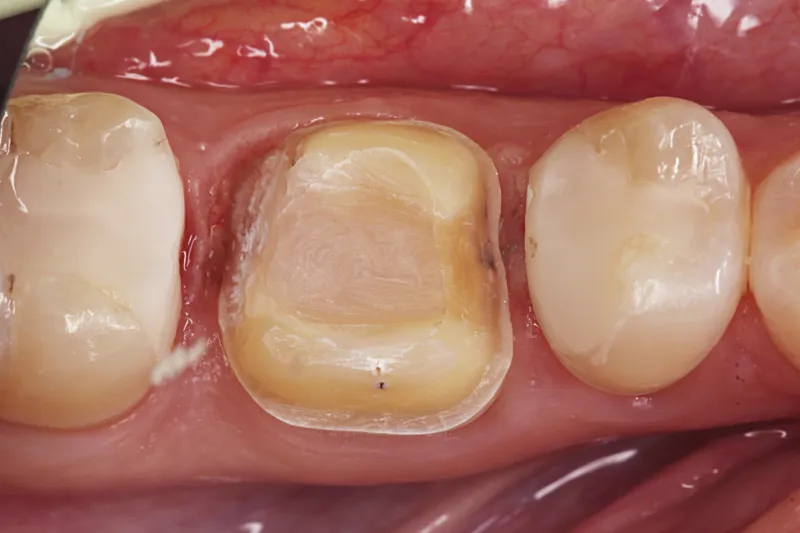Endokroner som alternativ restaurerende behandling til stiftretinerede kroner ved rodbehandlede tænder
Formålet med dette systematiske review er at beskrive endokroner som alternativ restaurerende behandling til stiftretinerede kroner ved rodbehandlede tænder.

Introduktion – Formålet med dette systematiske review er at beskrive endokroner som alternativ restaurerende behandling til stiftretinerede kroner ved rodbehandlede tænder. Den nyeste litteratur er systematisk gennemgået for at afdække følgende: 1) Proceduren bag fremstillingen, herunder præparation og materiale, 2) Fordele og ulemper forbundet med endokroner sammenholdt med stiftretinerede kroner og 3) Evidensen for endokroner i in vivo-studier.
Materiale og metode – Søgningen i PubMed resulterede i 132 artikler. Heraf blev 36 studier frasorteret, da disse var ældre end fem år. Derefter blev 96 studier screenet på baggrund af titel og abstract ud fra in- og eksklusionskriterier. I alt 21 artikler blev inkluderet.
Resultater – Resultaterne af in vitro-studierne viste, at endokronen udviste højere frakturstyrke og lavere andel af katastrofale frakturer med 1 mm ferrule, 2 mm ekstension i pulpakammeret og ingen ekstension i rodkanalen. Endokronens okklusaltykkelse var afhængig af materialevalget. Zirkonia udviste de bedste mekaniske egenskaber sammenlignet med lithiumdisilikat og leucitforstærket glaskeramik. Endokronen udviste forøgede mekaniske egenskaber samt lavere incidens af brud i den posteriore region sammenlignet med den stiftretinerede krone. Den stiftretinerede krone udviste derimod de bedste mekaniske egenskaber i den anteriore region. Generelt er andelen af kliniske studier om endokroner begrænset. De kliniske studier viser gode resultater for endokroners succes- og overlevelsesrate. Dog er studierne ikkerandomiserede kohortestudier og alle præget af en høj risiko for bias, hvorfor resultaterne er inkonklusive.
Konklusion – In vitro-studierne viser, at endokroner potentielt kan være en alternativ restaurerende behandling til den stiftretinerede krone i den posteriore region. Der mangler dog generelt randomiserede, kontrollerede studier, der sammenligner succes- og overlevelsesrate af endokroner med stiftretinerede kroner.
Klinisk relevans:
I dag anbefales kronebehandling af rodbehandlede tænder for at øge prognosen og overlevelsen af disse tænder. Hidtil har man behandlet rodbehandlede tænder med konventionelle kroner og afhængigt af resttandsubstans anvendt makromekanisk retention i form af henholdsvis plastisk opbygning, plastisk opbygning med præfabrikeret stift eller støbt stift. Nyere adhæsive teknikker har gjort det muligt i højere grad at anvende mikromekanisk retention fremfor makromekanisk retention, hvilket har muliggjort endokroner. Endokronen er en helkeramisk krone, der makromekanisk forankres i pulpakammeret og mikromekanisk forankres gennem adhæsive teknikker. Fordelene ved endokronen er: ingen risici ved stiftudboring, nemmere at tilgå kanaler i tilfælde af revision, lavere økonomisk udgift for patienten samt tidsbesparende grundet færre behandlingstrin.Endocrowns as an alternative restoration to post-retained crowns on endodontic treated tooth. A systematic review.
Introduction – The purpose of this systematic review is to evaluate the use of endocrowns, as a mean to restorative treatment on endodontically treated teeth. Based on the most recent publications, the following aspects of endocrowns are examined: 1. The manufacturing of the endocrown, including the preparation and material, 2. The advantages and disadvantages, in comparison to post and core crowns, 3. The evidence for endocrowns in in vivo studies.
Materials and methods – The search in PubMed identified 132 publications. Of which 36 studies were published prior to our defined 5-year limitation. Subsequently 96 studies were screened from title and abstract based on in- and exclusion criteria. In total 21 papers were included.
Results – The outcome of the in vitro studies indicates, that endocrowns show higher fracture strength and a lower amount of catastrophic fractures with a 1 mm ferrule, a 2 mm extension in the pulp chamber, and no extension in the root canals. The preferred occlusal thickness of the endocrown depends on the chosen material. Zirkonia showed the best mechanical properties, compared to lithium disilicate and leucite based glass ceramic. The endocrown displays greater mechanical abilities, and low incidence of failures in the posterior region, compared to post and core crowns. While on the contrary post and core crowns are superior in the anterior region. The clinical studies indicate favorable clinical results and survival for endocrowns. Despite this, the studies are non randomized cohort studies and generally carry a high risk of bias, why the results are inconclusive.
Conclusion – The in vitro studies show that endocrowns may be an alternative restorative treatment to post and core crowns, with promising results in the posterior region. However, there is a lack of randomized, controlled studies that compares success- and survival rate of endocrowns with post and core crowns.


